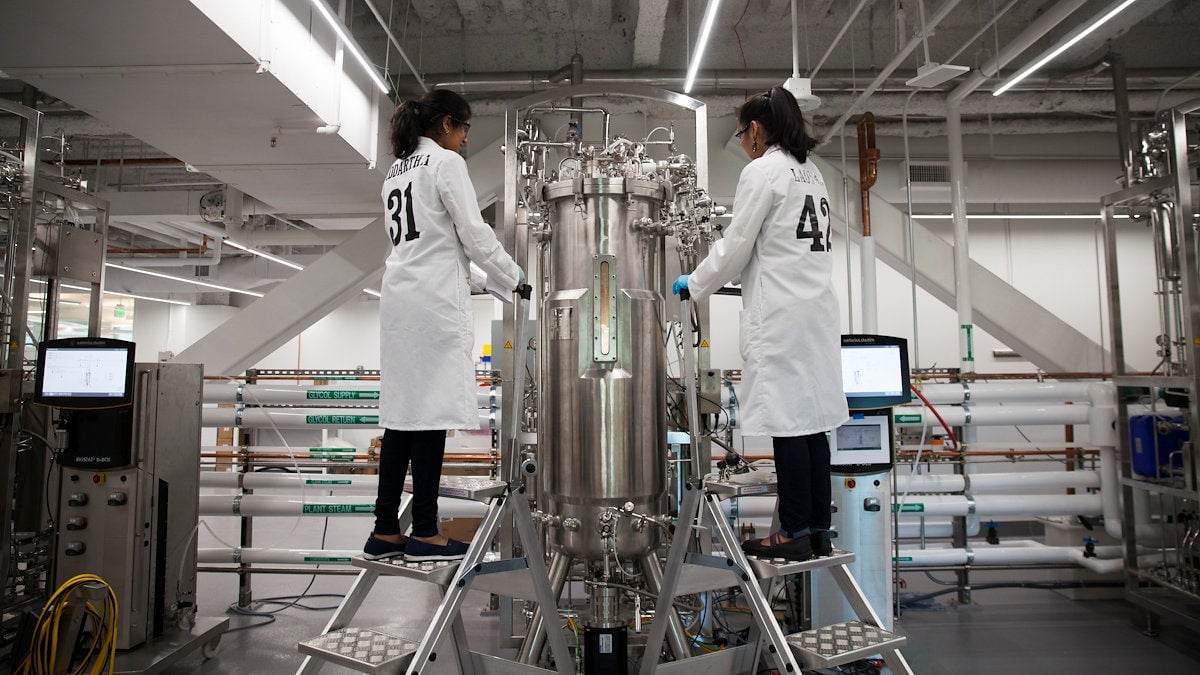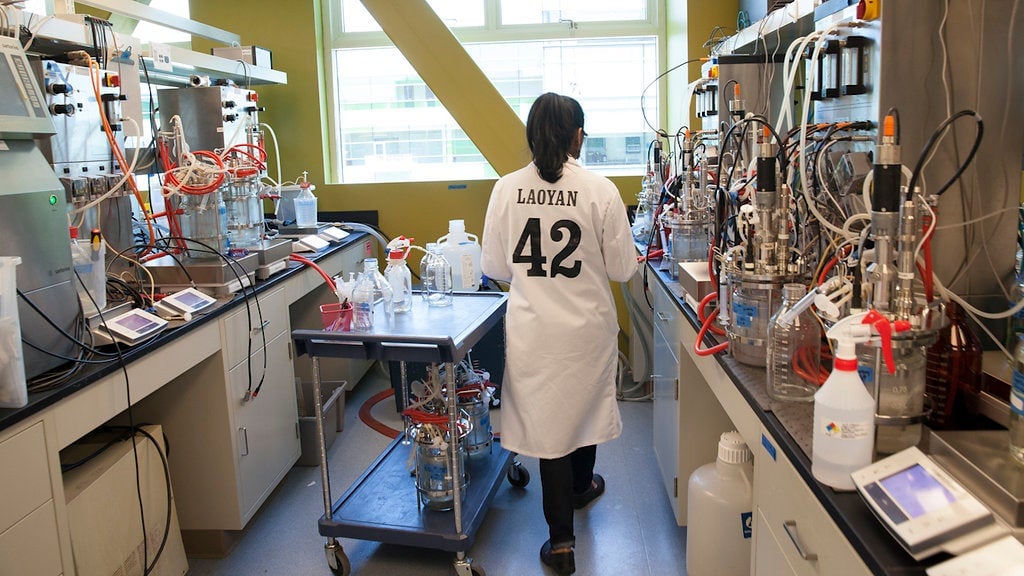Synthetic spider silk could be the biggest technological advance in clothing since nylon
Spider silk’s qualities are nearly mythical. Its tensile strength is comparable to steel’s. Yet it is lighter, and can be as stretchy as a rubber band. Those traits in combination make it tougher than Kevlar. To give you an idea: If the spider webs that shoot from Spider Man’s wrists were real spider silk, the superhero could genuinely have pulled the runaway train to a halt in that dramatic scene in Spider Man 2.


Spider silk’s qualities are nearly mythical. Its tensile strength is comparable to steel’s. Yet it is lighter, and can be as stretchy as a rubber band. Those traits in combination make it tougher than Kevlar. To give you an idea: If the spider webs that shoot from Spider Man’s wrists were real spider silk, the superhero could genuinely have pulled the runaway train to a halt in that dramatic scene in Spider Man 2.
So it’s no surprise that the race is on to create a synthetic version.
After years of hype and false starts, including one now-bankrupt effort that involved genetically modified goats producing it in their milk, a few companies think they’ve figured it out. The two leading the pack are Spiber, a Japanese company, and a California-based startup called Bolt Threads. Bolt Threads believes it has the edge, and that spider silk is only the beginning of what it can do.

“We make protein microfibers, and they are inspired by nature, starting with spiders,” says Sue Levin, Bolt Threads’ chief marketing officer. “But we can riff off that in literally infinite directions.”
A real spider generates silk in specialized glands in its abdomen, and creates the silk strands using a spinning organ called a spinneret. Some spiders produce up to seven types of silk, each with its own purpose and attributes.
But unlike silkworm silk, which silkworms produce to make their cocoons (the stuff used for diaphanous dresses and smart neckties), spider silk can’t be farmed in large quantities because spiders are cannibals, and will eat one another in close quarters.
Bolt Threads doesn’t use spiders to make its silk. The principal ingredients are genetically modified yeast, water, and sugar. The raw silk is produced through fermentation, much like brewing beer, except instead of the yeast turning the sugar into alcohol, they turn it into the raw stuff of spider silk. Bolt Threads spins that into threads using a method similar to the wet-spinning process used to create cellulose-based fibers such as Lyocell. Levin says it’s molecularly the same as natural spider silk, except for a few deliberate variations that only a chemical biologist would recognize.
Synthetic spider silk could be used for everything from automobile parts to medical devices to performance outdoor gear, which is the area that’s attracting some of the most attention thus far. Bolt Threads recently announced a $50 million round of funding, as well as a new partnership with the outdoor brand Patagonia, which demonstrates a major vote of confidence in its technology.
Neither Bolt Threads nor Patagonia will give details on what products they’re working on just yet, but Matt Dwyer, Patagonia’s director of material innovation, promises when something does come out, it will be “awesome.”
“We think they’ve cracked the code,” he says. ”For them to have come up with this capability… is just the kind of stuff that blows your mind.”
Bolt Threads says it is on the verge of a decades-long textile revolution, similar to the one that the chemical giant DuPont kicked off in the 1930s when it invented nylon. Made from chemicals found in petroleum, nylon was the first true artificial fiber. It led to many of the synthetics used in our clothes and just about everywhere else today, including polyester, Lycra, and Kevlar, the materials that make up the growing high-performance clothing industry.
“It all comes basically from the same building blocks,” Levin says of those DuPont creations. “That’s exactly what we’re saying, except our building blocks are proteins, not hydrocarbons.”

What that means is the company can theoretically mimic, or even improve upon, any natural, protein-based fiber, such as wool. Natural fibers have evolved for performance over thousands of years. They can be tougher, as well as more comfortable, than synthetics.
Steve Arcidiacono, a microbiologist at the US Army’s Natick Solider Systems Center, which researches and develops products such as clothing for soldiers, says the US military has been following the progress of companies such as Bolt Threads, as well as supporting development of synthetic spider silk itself. “With genetic engineering, they can engineer functionality right into the fiber,” he says.
He believes it’s “theoretically” possible for manmade, protein-based fibers to replace some widely used synthetics, such as nylon. The appeal to the US military is clear. It relies on nylon for its strength, but when heated enough, nylon melts rather than burns. That’s dangerous for soldiers in combat situations. Protein-based fibers don’t do that, and could be lighter and stronger.
The issues holding back manmade spider silk have always been producing it in large quantities and developing the right spinning process. Arcidiacono believes that if these companies have solved these issues as they claim, we could see their products appearing in targeted applications first, and then spreading widely through the consumer market.
Protein-based synthetics have another big advantage: They’re far more sustainable than products derived from oil. The ingredients are all renewable, and unlike petroleum-derived fabrics, they’re biodegradable. Bolt Threads says its silk also requires fewer toxic chemicals for dyeing, which is one of the dirtiest parts of making fabric. And because the company is developing new manufacturing methods just to create their product, the goal is to build them to be cleaner than current technology.
Most of Bolt Threads’ competitors use a different method, employing genetically modified E.coli bacteria to create their silk. Spiber uses E.coli, too, though it says it uses different microorganisms depending on the gene sequences it wants to make. To date, the company says it has designed and synthesized more than 600 original proteins, based on types that exist in nature, but with some modifications to their amino-acid makeup.
Spiber has already made a spider-silk parka in collaboration with Goldwin, the Japanese sportswear brand that also serves as The North Face’s Japanese distributor. The Moon Parka is set to go on sale in limited quantities under The North Face name this year, but it’s not cheap—and that’s even when it’s priced lower than it should be. The version of the parka that uses conventional materials costs 80,000 yen ($768). A senior executive told Bloomberg that the synthetic spider-silk version should be priced “much higher,” but they’re limiting it to no higher than 120,000 yen, he said, so that people buy them.

Spiber’s other challenge is scaling up production. “We are currently at pilot scale, and working towards moving into mass production in the near future,” a spokesperson for the company said.
The company has more announcements forthcoming, but Bolt Threads may have some key advantages. Even though it won’t have a product on the market first, it’s already producing silk in kilos, and plans to start churning silk out on the order of metric tons this year. It plans to have some demo textiles and even a few products up for sale in the next 12 to 18 months, too. Levin says using yeast is also “significantly less expensive” than using E.coli. They expect their fabric to cost about as much as other premium fabrics, such as high-end wools or natural silk.
That’s where the real challenges lie for synthetic spider silk, whether it’s made by Bolt Threads, Spiber, or anyone else. It will likely only find a mass audience if it offers a performance advantage and is competitive on cost. Synthetics can range in price, but there are plenty of inexpensive options available, and it’s arguably not evident that spider silk could offer enough of a performance advantage in a jacket to justify the price premium at this point.
Both Levin and Dwyer at Patagonia emphasize one point over and over, though. They aren’t just thinking about the potential of protein-based synthetics over the next year. They’re thinking about it over the next decades.